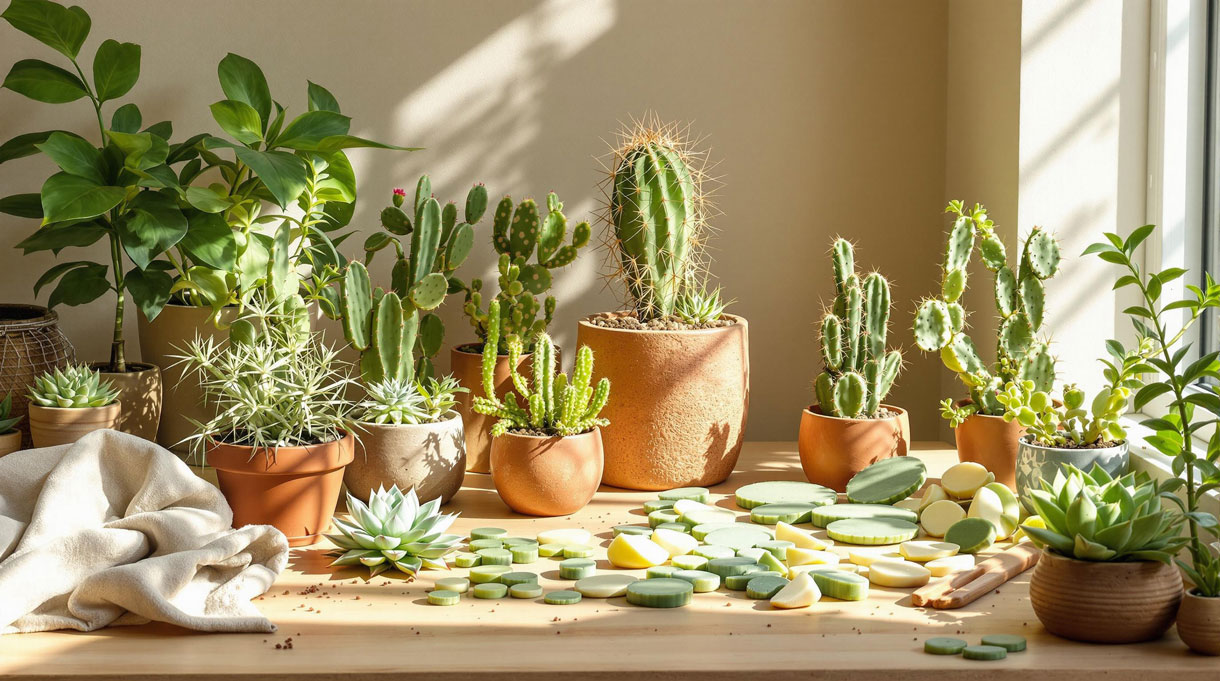Growing cacti from cuttings is one of the easiest and most rewarding ways to propagate these unique and resilient plants. Whether you’re a beginner looking to expand your collection or an experienced gardener experimenting with propagation techniques, cuttings offer a quick and effective method to grow new cacti.
Compared to growing cacti from seeds—which can take years to mature—cuttings provide a faster and more reliable solution for expanding your cactus collection. In this guide, we’ll cover everything you need to know about selecting, preparing, and planting cactus cuttings, ensuring your new plants thrive.
Understanding cactus cuttings
What are cactus cuttings?
Cactus cuttings are pieces of the plant—such as stems or pads—that can grow into a new cactus when planted in suitable conditions. Unlike seeds, which take time to germinate and mature, cuttings are an efficient way to create a clone of the parent plant, preserving its unique characteristics.
To make this process easier to visualize, here are the most common types of cactus cuttings:
- Stem cuttings: Typically used for columnar cacti like Cereus.
- Pad cuttings: Ideal for species like Opuntia (Prickly Pear).
- Segment cuttings: Common for tropical cacti like the Christmas Cactus.
Why grow cacti from cuttings?
Propagation through cuttings offers several advantages:
- It’s faster than growing from seeds.
- It ensures the new plant has the same traits as the parent cactus.
- It’s a simple process requiring minimal equipment.
Compared to other methods like offsets or water propagation, cuttings strike a balance between efficiency and success rate.
Choosing the right cactus for cuttings
Types of cacti that propagate well via cuttings
Some cacti are more suited for propagation by cuttings than others. Popular options include:
- Opuntia (Prickly Pear): Known for its flat, paddle-shaped segments.
- Echinopsis: Produces offshoots that are easy to separate.
- Christmas Cactus: A tropical cactus with segmented stems.
- Cereus: Columnar cacti that grow tall and can be propagated from stem sections.
When to take cactus cuttings
The best time to take cuttings is during the active growing season, typically in spring or early summer. Avoid taking cuttings during dormancy in winter, as the plant’s slower metabolism may hinder rooting.
Tip: Select a healthy parent plant that is free from pests, rot, or signs of disease. Healthier cuttings have a much higher success rate.
Step-by-step guide to taking cactus cuttings
Tools and materials needed
Before you begin, gather these essentials:
- A sterilized knife or pruning shears (sanitize with rubbing alcohol).
- Gardening gloves for protection.
- A flat surface for drying the cuttings.
- Rooting hormone (optional).
- Tongs (for handling spiny varieties).
How to cut properly
- Select a healthy parent cactus with no signs of disease or pests.
- Use a sharp, sterilized knife or pruning shears to make a clean cut.
- For columnar cacti: Cut a 6- to 12-inch section of the stem.
- For pad-forming cacti: Detach an entire pad at the joint.
- Avoid jagged cuts, as they take longer to heal and may invite rot.
- Handle spiny cacti carefully using thick gloves or tongs to avoid injury.
Letting the cutting callus
After taking the cutting, allow it to heal or “callus” before planting. This involves:
- Placing the cutting in a dry, shaded area.
- Letting it sit for 1–2 weeks until the cut end develops a tough, dry surface.
Why is callusing important? A callused end prevents moisture from entering the cutting, reducing the risk of rot when planted.
Preparing the soil and planting the cutting
Choosing the right soil
Cacti thrive in well-draining soil to prevent root rot. Use a commercial cactus mix or create your own by mixing: one part potting soil with one part coarse sand. Be sure to plant your cactus in a pot with drainage holes to allow excess water to escape. When growing cacti, it’s important to give them plenty of sunlight and only water them when the soil is completely dry. Overwatering can be detrimental to their health, so it’s important to monitor their water intake carefully.
- 2 parts sandy soil,
- 1 part perlite or pumice, and
- 1 part organic matter (optional).
Tip: Avoid heavy potting soil, which retains too much moisture.
How to plant the cutting
- Fill the pot with your prepared soil mix.
- Insert the callused end of the cutting about 1–2 inches deep into the soil.
- Support larger cuttings with small stakes if needed.
- Do not water immediately—wait at least a week to allow the cutting to adjust.
Conclusion
Growing cacti from cuttings is a simple and rewarding process that allows gardeners to expand their collections with ease. By following the steps outlined above, you can ensure successful propagation and enjoy the beauty of your thriving cacti. Grab some cuttings and start your propagation journey today!
FAQs
| Question | Answer |
|---|---|
How long does it take for a cactus cutting to root? |
Rooting usually takes 4–6 weeks, depending on the cactus type and environmental conditions. Patience is key! |
Can cactus cuttings be rooted in water? |
Yes, but it’s not ideal for most cacti as it increases the risk of rot. Soil propagation is safer and more reliable. |
How do you cut a cactus without getting poked? |
Wear thick gloves and use tongs to handle the cactus while cutting. |
How long should cactus cuttings dry before planting? |
Allow cuttings to dry (callus) for 1–2 weeks before planting. |
